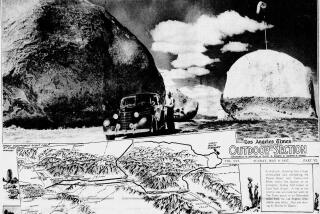Visitors Still Flock to Trinity Site : Twice a year, the area in New Mexico where the first atom bomb was tested is open to the public.
- Share via
WHITE SANDS MISSILE RANGE, N.M. — Driving across the Southwestern desert to stand at the ground-zero point of an atomic explosion sounds like a strange way to spend a Saturday. But twice each year, several thousand people do just that in a pilgrimage to Trinity Site in the New Mexico desert northwest of Alamogordo.
It was here, on July 16, 1945, that the first atom bomb was tested, and each year, on the first Saturdays of April and October, the Army, which administers the site as part of White Sands Missile Range, opens it to the public for a few hours, free of charge. This fall, the semi-annual event will take place Oct. 3, between the hours of 8 a.m. and 2 p.m.
The response to the Army’s invitation--first extended in 1965--has been overwhelming. This spring, 3,600 people drove to the site, where a 10-foot lava obelisk marks the ground-zero spot.
Many were probably expecting a dramatic crater, or a rock surface that had been fused to glass or blasted bare of all vegetation.
But that isn’t what they found. “It looks like the desert four miles away,” says Missile Range representative Nancy Dumas. “To be honest, there’s not a lot to see.”
Visitors would probably troop to the site even if there was nothing there at all, but the Army assists them by setting up the casing of a Fat Man atom bomb, the type that exploded here that day in 1945, within 50 yards of the original site. There is no permanent visitor center, but the Army also posts a series of 30 photos of the explosion along a fence near the obelisk. Visitors are allowed inside the fence, where they will find a footing from the 100-foot tower that held the bomb, and a shelter protecting a piece of the original surface. The ground was fused into what scientists named “trinitite,” after the location--a green, glass-like substance produced when the heat of the blast seared the sandy surface to a depth of a quarter inch.
The entire blast site was once covered with trinitite, but before it was opened to the public, most of the material--which is radioactive--was carted away or buried. A large sheet of trinitite is believed to still be intact beneath a layer of dirt inside the shelter, but at present, only silver-dollar-sized pieces are visible. Pebble-sized shards can also be found outside the shelter.
Two miles south of the test site is the McDonald Ranch, where the plutonium core for the bomb was assembled. The ranch has been restored to its 1945 condition, and a shuttle bus carries visitors to it from ground zero.
The McDonalds had nothing to do with the bomb other than owning a sheep and cattle ranch in an isolated enough location that the government decided to appropriate it. But the ranch house, says Dumas, gives an idea of what ranch life was like in isolated locations like this in the 1920s and ‘30s, when the family that lived here only traveled to town twice a year.
But the taste of isolated ranch life is only a sideshow. The real attraction is the blast site, even if the earth seems to have absorbed it without visible trace.
Traces of the blast linger not only in the collective memory, but in the form of a radiation level that while surprisingly low, is 10 times higher than background. Still, on a short visit, people don’t have to worry about large radiation exposures, says Dumas: “You’re likely to receive a higher dose on a flight from New York.”
Visitors come to Trinity Site from either of two directions. Most enter the Missile Range from the north, through a well-marked gate 12 miles east of the town of San Antonio, N.M., on U.S. 380, then five miles south on New Mexico 525. The gate opens at 8 a.m. and closes promptly at 2 p.m. The site is 17 miles further. Peak hours are 9 a.m. to noon, when there can be waits for the shuttle bus to the ranch.
A second group of visitors assembles at the Otero County Fairground, just north of Alamogordo, to caravan to the site under the care of the Alamogordo Chamber of Commerce and the Army. The escort is free. The caravan leaves at 8 a.m. and returns at about 12:30 p.m., though visitors are free to exit earlier via the north entrance. The distance is 180 miles, round trip on paved roads, with no gas stations available. But water, hot dogs and snacks are available at the site.
For more information, including possible schedule changes in 1993, contact White Sands Missile Range Public Affairs Office, White Sands Missile Range, N.M. 88002-5047, (505) 678-1134 or 678-1135.
More to Read
Sign up for The Wild
We’ll help you find the best places to hike, bike and run, as well as the perfect silent spots for meditation and yoga.
You may occasionally receive promotional content from the Los Angeles Times.






